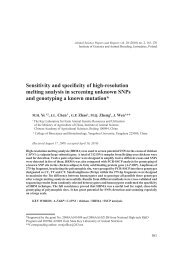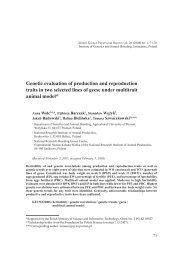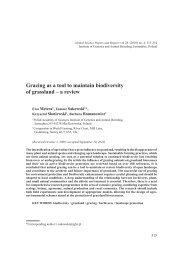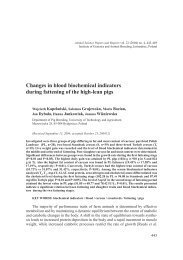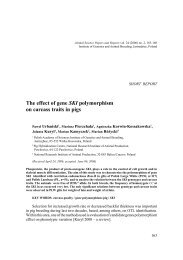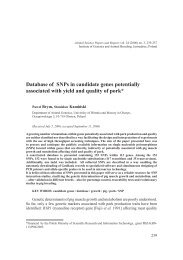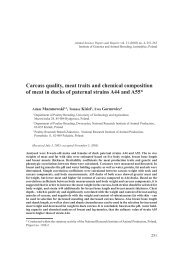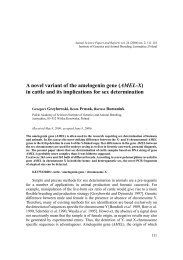Hoof size as related to body size in the horse (Equus caballus)
Hoof size as related to body size in the horse (Equus caballus)
Hoof size as related to body size in the horse (Equus caballus)
You also want an ePaper? Increase the reach of your titles
YUMPU automatically turns print PDFs into web optimized ePapers that Google loves.
<strong>Hoof</strong> <strong>size</strong> <strong>as</strong> <strong>related</strong> <strong>to</strong> <strong>body</strong> <strong>size</strong> <strong>in</strong> <strong>the</strong> <strong>horse</strong><br />
<strong>in</strong> <strong>horse</strong>s of same weight but different type can differ. The <strong>horse</strong> condition may also<br />
affect <strong>the</strong> result.<br />
Turner [1992] suggested <strong>to</strong> use <strong>the</strong> maximum <strong>body</strong> weight (B, lb) <strong>to</strong> coronary<br />
rim circumference (C, <strong>in</strong>ch) ratio <strong>as</strong> follows: B = 78 x C 2 / 12.56. If <strong>in</strong> <strong>the</strong> formula we<br />
use centimeters and kilograms <strong>as</strong> units, a <strong>horse</strong> of 550 kg <strong>body</strong> weight should have<br />
<strong>the</strong> coronary rim of at le<strong>as</strong>t 35 cm. However, accurate me<strong>as</strong>ur<strong>in</strong>g of <strong>the</strong> coronary<br />
rim also seems difficult. S<strong>as</strong>imowski et al. [1994] found <strong>the</strong> hoof ground surface<br />
outl<strong>in</strong>e <strong>to</strong> height at wi<strong>the</strong>rs and <strong>to</strong> <strong>body</strong> weight ratios varied considerably <strong>in</strong> different<br />
breeds of small <strong>horse</strong>s and ponies: from 64.3 <strong>to</strong> 79.4% and from 26.9 <strong>to</strong> 32.9%,<br />
respectively. Kummer et al. [2005] found some mild positive correlations between <strong>the</strong><br />
hoof parameters and <strong>the</strong> <strong>horse</strong>s’ height at wi<strong>the</strong>rs.<br />
In <strong>the</strong> analysis of <strong>the</strong> hoof <strong>size</strong> relative <strong>to</strong> <strong>the</strong> <strong>body</strong> <strong>size</strong>, besides various types of<br />
<strong>horse</strong>s, <strong>the</strong> age of animals should be taken <strong>in</strong><strong>to</strong> account. The <strong>size</strong> of <strong>the</strong> hoof raises<br />
up <strong>to</strong> <strong>the</strong> age of six years and bigger hooves <strong>in</strong> older <strong>horse</strong>s grow slower. The hoof<br />
wall length grows 0.5 mm daily <strong>in</strong> suckl<strong>in</strong>gs and 0.2 mm <strong>in</strong> adults [Butler 1995]. In<br />
addition <strong>to</strong> <strong>the</strong> <strong>size</strong>, <strong>the</strong> shape of <strong>the</strong> capsule is important <strong>in</strong> fulfill<strong>in</strong>g <strong>the</strong> functions of<br />
<strong>the</strong> hooves.<br />
The study aimed at determ<strong>in</strong><strong>in</strong>g <strong>the</strong> fore hoof <strong>to</strong> <strong>body</strong> dimension ratios and<br />
correlations between <strong>the</strong>se two groups of values. Ano<strong>the</strong>r objective w<strong>as</strong> <strong>to</strong> def<strong>in</strong>e <strong>the</strong><br />
most reliable parameter of <strong>the</strong> hoof <strong>size</strong> <strong>in</strong> relation <strong>to</strong> <strong>the</strong> <strong>body</strong> <strong>size</strong>, which could be<br />
e<strong>as</strong>ily used <strong>in</strong> judg<strong>in</strong>g <strong>the</strong> <strong>horse</strong>’s conformation and applied <strong>in</strong> <strong>the</strong> selection improv<strong>in</strong>g<br />
<strong>the</strong> hoof <strong>size</strong>.<br />
Material and methods<br />
The mares of four breeds belong<strong>in</strong>g <strong>to</strong> different orig<strong>in</strong> types were exam<strong>in</strong>ed:<br />
Purebred Arabian (PA, n=18) and halfbred Anglo-Arabian (AA, n=25) of warmblood<br />
type, Polish Konik (PK, n=12) of primitive type and Polish Cold-Blood (PCB, n=22),<br />
77 mares <strong>in</strong> <strong>to</strong>tal. The mares were <strong>the</strong> property of big Polish studs: Janów Podl<strong>as</strong>ki,<br />
Florianka (Roz<strong>to</strong>cze National Park <strong>in</strong> Zwierzyniec) and Nowe Jankowice. The study<br />
w<strong>as</strong> performed exemplified <strong>in</strong> <strong>the</strong> mares <strong>in</strong> order <strong>to</strong> <strong>in</strong>vestigate homogenous groups<br />
big enough for statistical analysis. The mares were cl<strong>as</strong>sified <strong>to</strong> three age groups:<br />
4-6, 7-9 and 10-13 year olds. To determ<strong>in</strong>e <strong>the</strong> <strong>size</strong> and bon<strong>in</strong>ess of <strong>the</strong> <strong>horse</strong>, <strong>the</strong><br />
follow<strong>in</strong>g <strong>body</strong> traits were me<strong>as</strong>ured:<br />
– height at wi<strong>the</strong>rs (with a stick, 1 cm accuracy);<br />
– chest circumference (with a tape, 1 cm accuracy);<br />
– left fore cannon circumference (with a tape, 0.5 cm accuracy).<br />
Index of bon<strong>in</strong>ess (%) w<strong>as</strong> calculated <strong>as</strong> <strong>the</strong> left cannon circumference <strong>to</strong> <strong>the</strong><br />
height at wi<strong>the</strong>rs ratio.<br />
In all <strong>the</strong> mares <strong>the</strong> follow<strong>in</strong>g traits of <strong>the</strong> left fore hoof were me<strong>as</strong>ured with a<br />
caliper, after trimm<strong>in</strong>g, with a 1 mm accuracy:<br />
215



